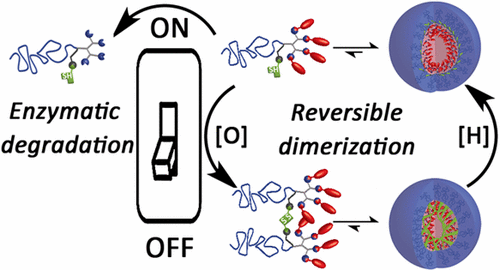当前位置:
X-MOL 学术
›
Biomacromolecules
›
论文详情
Our official English website, www.x-mol.net, welcomes your feedback! (Note: you will need to create a separate account there.)
Reversible Dimerization of Polymeric Amphiphiles Acts as a Molecular Switch of Enzymatic Degradability
Biomacromolecules ( IF 6.2 ) Pub Date : 2017-09-22 00:00:00 , DOI: 10.1021/acs.biomac.7b01150 Ido Rosenbaum 1, 2 , Ram Avinery 2, 3 , Assaf J. Harnoy 1, 2 , Gadi Slor 1, 2 , Einat Tirosh 2, 4 , Uri Hananel 2, 4 , Roy Beck 2, 3 , Roey J. Amir 1, 2, 5
Biomacromolecules ( IF 6.2 ) Pub Date : 2017-09-22 00:00:00 , DOI: 10.1021/acs.biomac.7b01150 Ido Rosenbaum 1, 2 , Ram Avinery 2, 3 , Assaf J. Harnoy 1, 2 , Gadi Slor 1, 2 , Einat Tirosh 2, 4 , Uri Hananel 2, 4 , Roy Beck 2, 3 , Roey J. Amir 1, 2, 5
Affiliation

|
Enzyme-responsive polymeric micelles have great potential as drug delivery systems due to the high selectivity and overexpression of disease-associated enzymes, which could be utilized to trigger the release of active drugs only at the target site. We previously demonstrated that enzymatic degradation rates of amphiphilic PEG-dendron hybrids could be precisely tuned by gradually increasing the hydrophobic to hydrophilic ratio. However, with the increase in hydrophobicity, the micelles rapidly became too stable and could not be degraded, as often encountered for many other amphiphilic assemblies. Here we address the challenge to balance between stability and reactivity of enzymatically degradable assemblies by utilizing reversible dimerization of diblock polymeric amphiphiles to yield jemini amphiphiles. This molecular transformation serves as a tool to control the critical micelle concentration of the amphiphiles in order to tune their micellar stability and enzymatic degradability. To demonstrate this approach, we show that simple dimerization of two polymeric amphiphiles through a single reversible disulfide bond significantly increased the stability of their micellar assemblies toward enzymatic degradation, although the hydrophilic to hydrophobic ratio was not changed. Reduction of the disulfide bond led to dedimerization of the polymeric hybrids and allowed their degradation by the activating enzyme. The generality of the approach is demonstrated by designing both esterase- and amidase-responsive micellar systems. This new molecular design can serve as a simple tool to increase the stability of polymeric micelles without impairing their enzymatic degradability.
中文翻译:

两性聚合物的可逆二聚作用是酶降解能力的分子开关。
酶反应性高分子胶束具有很高的潜力,因为与疾病相关的酶具有很高的选择性和过表达性,因此可以作为药物递送系统,仅可用于触发活性药物在靶位点的释放。我们先前证明,通过逐渐增加疏水性与亲水性的比率,可以精确地调节两亲性PEG-树枝状杂化体的酶促降解速率。然而,随着疏水性的增加,胶束迅速变得太稳定并且不能降解,这是许多其他两亲性装配体经常遇到的情况。在这里,我们通过利用二嵌段聚合物两亲物的可逆二聚化产生空子两亲物来解决在酶可降解组装物的稳定性和反应性之间取得平衡的挑战。该分子转化用作控制两亲物的临界胶束浓度以调节其胶束稳定性和酶促降解性的工具。为了证明这种方法,我们显示了两个聚合两亲物通过一个可逆的二硫键的简单二聚化,虽然亲水/疏水比没有改变,但显着增加了它们的胶束组装体对酶促降解的稳定性。二硫键的还原导致聚合物杂化物的去二聚化并允许它们被活化酶降解。通过设计酯酶和酰胺酶反应的胶束系统可以证明该方法的普遍性。
更新日期:2017-09-23
中文翻译:

两性聚合物的可逆二聚作用是酶降解能力的分子开关。
酶反应性高分子胶束具有很高的潜力,因为与疾病相关的酶具有很高的选择性和过表达性,因此可以作为药物递送系统,仅可用于触发活性药物在靶位点的释放。我们先前证明,通过逐渐增加疏水性与亲水性的比率,可以精确地调节两亲性PEG-树枝状杂化体的酶促降解速率。然而,随着疏水性的增加,胶束迅速变得太稳定并且不能降解,这是许多其他两亲性装配体经常遇到的情况。在这里,我们通过利用二嵌段聚合物两亲物的可逆二聚化产生空子两亲物来解决在酶可降解组装物的稳定性和反应性之间取得平衡的挑战。该分子转化用作控制两亲物的临界胶束浓度以调节其胶束稳定性和酶促降解性的工具。为了证明这种方法,我们显示了两个聚合两亲物通过一个可逆的二硫键的简单二聚化,虽然亲水/疏水比没有改变,但显着增加了它们的胶束组装体对酶促降解的稳定性。二硫键的还原导致聚合物杂化物的去二聚化并允许它们被活化酶降解。通过设计酯酶和酰胺酶反应的胶束系统可以证明该方法的普遍性。



























 京公网安备 11010802027423号
京公网安备 11010802027423号